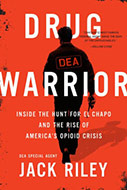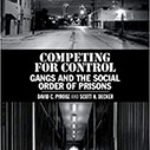Drug Warrior: Inside The Hunt For El Chapo and The Rise Of America’s Opioid Crisis

Author: Jack Riley with Mitch Weiss
Publisher: New York: Hachette Books, 2019. 272p.
Reviewer: Frederick T. Martens | July 2020
It was 1971, and I was working in an undercover capacity, buying heroin, methamphetamine, LSD, Quaaludes and marijuana throughout New Jersey. Then as now, we were facing a drug epidemic, with heroin ravaging communities both rich and poor. Believing that we were actually contributing in a positive way to the so-called “war on drugs,” arresting distributor/addicts was like “shooting fish in a barrel.” It took very little effort to make hundreds of arrests, racking up impressive body counts, or as former DEA Agent and principal author here, Jack Riley refers to them, metrics. Over a relatively short period of time, I realized that chasing the “low hanging fruit” had little effect on the drug markets, and may in fact have contributed to the consolidation of retail-level criminal organizations.
As a consequence, this budget-driven strategy was replaced with what came to be called the enterprise-theory of investigation. We (the New Jersey State Police and other law enforcement entities) began focusing on large scale criminal organizations and cartels, again believing that arresting the kingpins would over time, diminish the availability of illegal drugs. Again, however, we learned the laws of supply and demand often override enforcement strategies. The author here tacitly acknowledges this reality, but appears to ignore its history-bound lessons.
Strikingly, Riley and Weiss argue that even arresting drug kingpins and cartel leaders such as the head of the Sinaloa cartel, Joaquin Guzman (El Chapo) will have negligible effects on illicit drug importation or availability. The Sinaloa cartel, they say, “was a well-oiled machine, engineered to survive even the loss of its CEO. Its global supply chain and flexible distribution network were spread throughout the United States and the world. It wasn’t going away” (p. 180).
So, let us agree that drug enforcement is really about managing the drug crisis, and not about eliminating or reducing the availability of illegal drugs. Furthermore, let us agree that arresting drug kingpins is mostly about sending a message that no one is above the law. Essentially, that is the story that Riley and Weiss are telling us in this rather entertaining, no-holds-barred memoir.
Initially, my reading of Drug Warrior led me to seriously question the wisdom, or lack thereof, that Riley had acquired over his 32 years as a drug agent and administrator. Yes, he certainly has a story to tell, but it is not necessarily the one he thinks he is telling. Over the many decades I travelled throughout the law enforcement community, I encountered many Jack Rileys. Passionate, committed, seeing the world in terms of black and white, and good versus evil, they represent the heart and soul of what has long been our approach to drugs and crime. These “prohibitionists” are intent on upending what is clearly an enforcement conundrum that seemingly has no humane or healthy outcome.
What Drug Warrior tells us is that the “war on drugs,” a term that drives Riley crazy, is unwinnable. “No matter how many methamphetamine laboratories we dismantled or drug traffickers we arrested or criminal organizations we busted, nothing seemed to stop the drugs from spreading into more and more communities” (p.83).
Assembling a story that is filled with any number of vignettes and anecdotes, Riley and his collaborator Weiss populate it with irony, sarcasm, personal animus, and a typical antipathy toward politicians who “have no idea what happens on the front lines…sitting around in their safe suburban worlds where they don’t have to worry about street gangs, shootings, or drug dealers moving in next door” (p. 231).
If we were not addressing such a serious public health epidemic, Drug Warrior would be the perfect sequel to the iconic movie, Dumb and Dumber. It seems that the story that Riley and Weiss weave is one of not only a failed strategy, but of a dysfunctional law enforcement apparatus coupled with systemic political atrophy. Congress, they argue, has sponsored “multiple bills aimed at curbing drug trafficking and rampant opioid use, but none have become law” (p. 233). Really? Do they really believe that more laws and more money for enforcement are the answers?
Failing to draw upon lessons from the our historical experience with Prohibition, Riley ironically seems to revel in the numerous alcohol-fueled celebratory events that he participated in over his career; for example: “When El Chapo [leader of the Sinaloa cartel] was apprehended, news flashed across the television. From then on, none of us could pay for drinks; fellow patrons bought toast after toast. We were badly over served” (pp. 225-226).
When Riley was transferred to El Paso, Texas, he made it his goal, or rather his obsession, to get El Chapo. Taking over a DEA field office where morale was low, Riley made it his mission to change its culture. He met with a DEA agent and over a few beers was educated over what to expect “from a border that was utterly corrupt” (p. 94).
With respect to his distaste for the phrase “war on drugs,” it seems contradictory to read Riley arguing that “we have to attack, attack, and attack criminal organizations wherever they hide”; that ”the most powerful weapon against crime is simply cooperation”; that the DEA is a family of brave warriors; and, that he set up a “war room in DEA headquarters” to plot the routes of transportation that El Chapo was traversing! So much for the phrase “war on drugs” driving Riley crazy (p. 242).
To know Jack Riley is clearly to know a Damon Runyonese-type character; a person larger than life. He was obsessed with the capture of El Chapo. He elevated El Chapo to being “the most dangerous criminal in the world,” on a par with the late terrorist mastermind Osama Bin Laden. Riley refused to retire from the DEA until he saw El Chapo in a US jail, even though his life was under a perpetual death threat from the crime boss. Some, according to the book, regarded Riley as “the most famous Federal agent since Elliott Ness” ( p. 184).
Riley’s ultimate solution to the importation of drugs relies on what eco-criminologists refer to as “rational choice” theory, or essentially a cost/benefit analysis: “I believe in the end,” says Riley, “it’s fear that will reduce drug trafficking—the fear that the United States can, at any time, reach out and find you. No matter where you hide, no matter where you operate, we’ll shut your cartel down and bring you to justice.” But in saying this, Riley does not seem to fully account for or perhaps refuses to acknowledge the infinitesimal probabilities of being arrested and convicted as a cartel kingpin, compared to the enormous financial benefits accrued by those whose legitimate options in life may have been blocked, or who were just motivated by unrestrained greed and avarice.
The author makes the case that continuing a failing policy toward drug prohibition is the ultimate definition of insanity. For as he knowingly, but perhaps sheepishly (a term that does an injustice to Riley) must concede: “I never expect to see an end to our battle against illegal drugs and deadly addiction…We as a society will likely be dealing with illegal drugs, addiction, and its accompanying violence and death for the remainder of our existence” (p.242).
Riley’s memoir makes a compelling and irrefutable case on why a purely criminal justice approach cannot and will not succeed. The unvarnished, candid, and irreverent insights that Riley so willingly shares can be repeated ad infinitum by many of my former colleagues and myself, who also experienced the very hell of which Riley speaks.
Frederick T. Martens is a former Detective/Lieutenant in the New Jersey State Police. He is a member of the Law Enforcement Action Partnership (LEAP) which supports the reform of our drug laws. He is the former President of IASOC.


